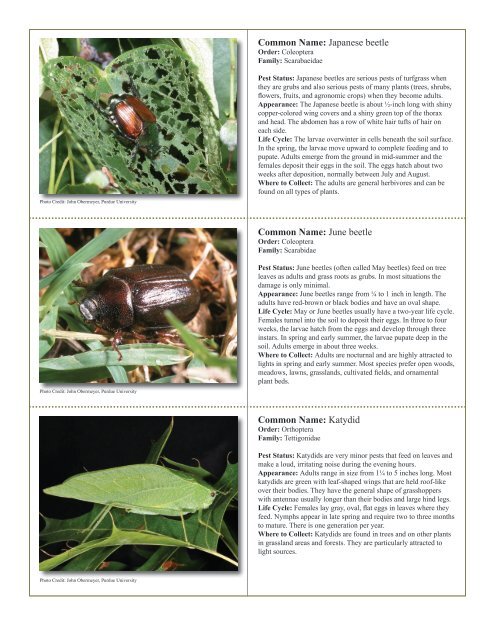to download pdf - Purdue Extension Entomology - Purdue University
to download pdf - Purdue Extension Entomology - Purdue University
to download pdf - Purdue Extension Entomology - Purdue University
You also want an ePaper? Increase the reach of your titles
YUMPU automatically turns print PDFs into web optimized ePapers that Google loves.
Common Name: Japanese beetle<br />
Order: Coleoptera<br />
Family: Scarabaeidae<br />
Pho<strong>to</strong> Credit: John Obermeyer, <strong>Purdue</strong> <strong>University</strong><br />
Pest Status: Japanese beetles are serious pests of turfgrass when<br />
they are grubs and also serious pests of many plants (trees, shrubs,<br />
flowers, fruits, and agronomic crops) when they become adults.<br />
Appearance: The Japanese beetle is about ½-inch long with shiny<br />
copper-colored wing covers and a shiny green <strong>to</strong>p of the thorax<br />
and head. The abdomen has a row of white hair tufts of hair on<br />
each side.<br />
Life Cycle: The larvae overwinter in cells beneath the soil surface.<br />
In the spring, the larvae move upward <strong>to</strong> complete feeding and <strong>to</strong><br />
pupate. Adults emerge from the ground in mid-summer and the<br />
females deposit their eggs in the soil. The eggs hatch about two<br />
weeks after deposition, normally between July and August.<br />
Where <strong>to</strong> Collect: The adults are general herbivores and can be<br />
found on all types of plants.<br />
Common Name: June beetle<br />
Order: Coleoptera<br />
Family: Scarabidae<br />
Pho<strong>to</strong> Credit: John Obermeyer, <strong>Purdue</strong> <strong>University</strong><br />
Pest Status: June beetles (often called May beetles) feed on tree<br />
leaves as adults and grass roots as grubs. In most situations the<br />
damage is only minimal.<br />
Appearance: June beetles range from ¼ <strong>to</strong> 1 inch in length. The<br />
adults have red-brown or black bodies and have an oval shape.<br />
Life Cycle: May or June beetles usually have a two-year life cycle.<br />
Females tunnel in<strong>to</strong> the soil <strong>to</strong> deposit their eggs. In three <strong>to</strong> four<br />
weeks, the larvae hatch from the eggs and develop through three<br />
instars. In spring and early summer, the larvae pupate deep in the<br />
soil. Adults emerge in about three weeks.<br />
Where <strong>to</strong> Collect: Adults are nocturnal and are highly attracted <strong>to</strong><br />
lights in spring and early summer. Most species prefer open woods,<br />
meadows, lawns, grasslands, cultivated fields, and ornamental<br />
plant beds.<br />
Common Name: Katydid<br />
Order: Orthoptera<br />
Family: Tettigonidae<br />
Pest Status: Katydids are very minor pests that feed on leaves and<br />
make a loud, irritating noise during the evening hours.<br />
Appearance: Adults range in size from 1¼ <strong>to</strong> 5 inches long. Most<br />
katydids are green with leaf-shaped wings that are held roof-like<br />
over their bodies. They have the general shape of grasshoppers<br />
with antennae usually longer than their bodies and large hind legs.<br />
Life Cycle: Females lay gray, oval, flat eggs in leaves where they<br />
feed. Nymphs appear in late spring and require two <strong>to</strong> three months<br />
<strong>to</strong> mature. There is one generation per year.<br />
Where <strong>to</strong> Collect: Katydids are found in trees and on other plants<br />
in grassland areas and forests. They are particularly attracted <strong>to</strong><br />
light sources.<br />
Pho<strong>to</strong> Credit: John Obermeyer, <strong>Purdue</strong> <strong>University</strong>
















